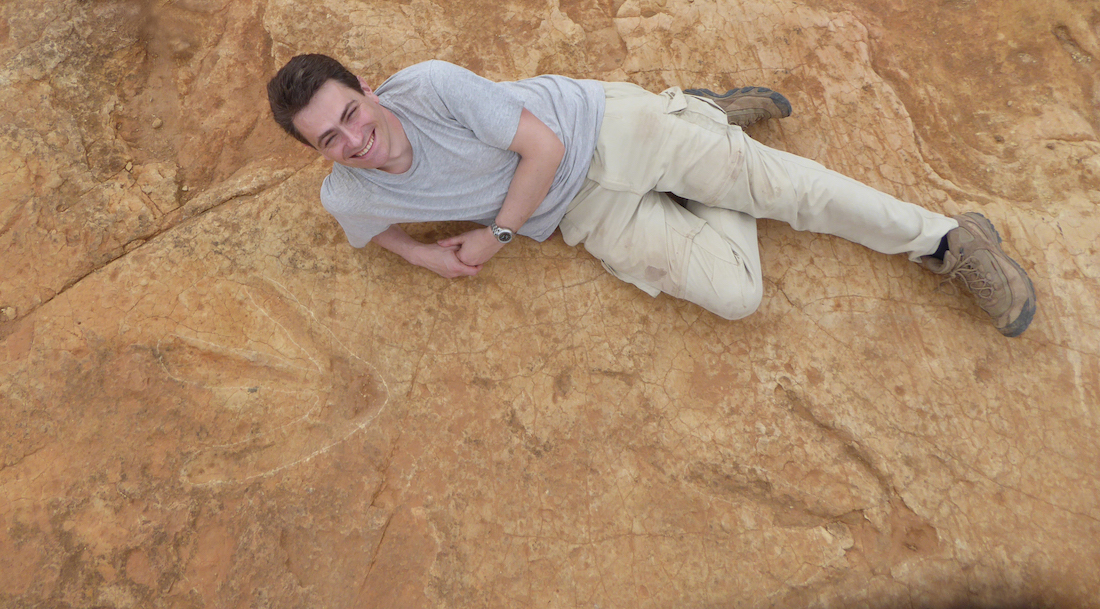Jurassic 'Mega-Carnivore' Dinosaur Was 4 Times the Size of a Lion

About 200 million years ago, a giant meat-eating dinosaur — one so large it was about twice as long as a giraffe is tall — left behind three-toed footprints as it trekked across the muddy ground, according to a new study.
Now, researchers are studying this massive dinosaur's fossilized footprints, as well as the footprints of slightly smaller bipedal dinosaurs that lived during the Jurassic period in what is now Lesotho, a country in southern Africa.
The largest three-toed footprints are 1.8 feet long and 1.6 feet wide (57 by 50 centimeters). That's a good 4 inches (10 cm) longer than the largest human foot on record — a title held by Robert Wadlow (1918-1940) an American whose feet were 1.5 feet (47 cm) long, according to Guinness World Records.
The dinosaur's enormous footprints indicate that its body measured up to 30 feet (9 meters) long, and just under 10 feet (3 m) tall at the hip, the researchers said. That length is four times the size of a lion, the largest modern carnivore in southern Africa, they added. [Images: Denali National Park's Amazing Dinosaur Tracks]
Given its robust size, the dinosaur is likely a megatheropod, the researchers said; this group of giant, two-legged, mostly carnivorous dinosaurs includes other large theropods, such as the fearsome Tyrannosaurus rex. They named the trackway Kayentapus ambrokholohali. (Just as with new animal species, trace fossils, such as trackways, also receive scientific names. The animal itself, however, has yet to receive a scientific name.)
The researchers found the tracks in Lesotho's Maseru district. The surrounding sandstone has ripple marks and "desiccation cracks" on it — signs of a prehistoric watering hole or riverbank, the researchers said.

The latest discovery is "very exciting," study co-researcher Fabien Knoll, a senior research fellow at the University of Manchester in the United Kingdom, said in a statement.
Sign up for the Live Science daily newsletter now
Get the world’s most fascinating discoveries delivered straight to your inbox.
"It is the first evidence of an extremely large meat-eating animal roaming a landscape otherwise dominated by a variety of herbivorous, omnivorous and much smaller carnivorous dinosaurs," Knoll said. "It really would have been [at the] top of the food chain."
The footprints are the largest theropod tracks in Africa, the researchers said. They're also quite old, dating to the early Jurassic, a time when most theropod dinosaurs were smaller. Back then, most theropods measured between 10 and 16 feet (3 to 5 m) long, with the larger ones reaching 23 feet (7 m) at most, the researchers said.
It wasn't until much later in the Jurassic and the Cretaceous that larger theropods, such as T. rex, appeared.
"This discovery marks the first occurrence of very large carnivorous dinosaurs in the early Jurassic of southern Gondwana, the prehistoric continent which would later break up and become Africa and other landmasses," lead study researcher Lara Sciscio, a postdoctoral research fellow at the University of Cape Town in South Africa, said in the statement. "Globally, these large tracks are very rare. There is only one other known site similar in age and sized tracks, which is in Poland."
The researchers also found smaller theropod footprints in the same area. These footprints are similar to other late Triassic and early Jurassic theropod footprints found in South Africa, Lesotho, Zimbabwe and Namibia, Sciscio said.
"In fact, there are numerous palaeosurfaces where footprints, and even tail and body impressions of these and other animals, can be found," she said. "But now, we have evidence this region of Africa was also home to a mega-carnivore."
The study was published online Oct. 25 in the journal PLOS ONE.
Original article on Live Science.

Laura is the archaeology and Life's Little Mysteries editor at Live Science. She also reports on general science, including paleontology. Her work has appeared in The New York Times, Scholastic, Popular Science and Spectrum, a site on autism research. She has won multiple awards from the Society of Professional Journalists and the Washington Newspaper Publishers Association for her reporting at a weekly newspaper near Seattle. Laura holds a bachelor's degree in English literature and psychology from Washington University in St. Louis and a master's degree in science writing from NYU.









